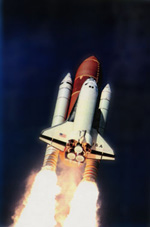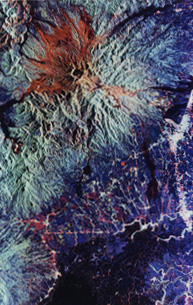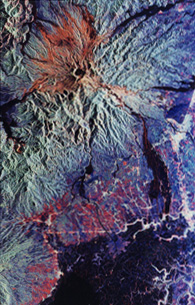
Courtesy
of NASA/JPL

The Space Shuttle launch |
In 1994, two missions known as SIR-C/X-SAR (Shuttle
Imaging Radar-C/X-Synthetic Aperture Radar), designed and carried on by NASA, DLR and ASI
(the American, German and Italian Space Agencies) took place in April and October. During
both missions, the SIR-C/X-SAR system aboard the Space Shuttle has the following
characteristics:
| Bands / frequencies (GHz) |
L, C, X/ 1.25, 5.3, 9.6 |
| Polarization |
L and C bands –
quadruple
X band – VV polarization |
| Incidence angle |
variable from 15° to 55° |
| Resolution |
30m X 30m |
|
The first SIR-C/X-SAR mission, aboard STS-59
(Space Transportation System-59), and launched on the 9th April 1994, collected
65 hours of data during the ten days of mission, roughly corresponding to 66 millions
square kilometers of observed Earth surface. The mission returned 47 terabits of data, the
equivalent of 30.000 encyclopaedia volumes. The STS –59 achieved 100% of the
SIR-C/X-SAR science objectives. In addition to taking high resolution data of all the
planned sites, the scientific team was able to adjust the time-line in order to observe
some phenomena in the very right moment they occurred on the Earth. For example, the
inundation in the mid-west of the U.S. and in Germany, or Cyclone Odille as it formed in
the Pacific Ocean or the thaw in Canada in spring.
 |
 |
Mount
Pinatubo, Aprile 14, 1994 |
Mount Pinatubo, Ottobre 5, 1994
Courtesy of NASA/JPL |
The second SIR-C/X-SAR mission took place in
October 1994 with the same payload aboard STS-68. One of the most important objectives of
the second flight was to acquire images of the same area of the first one to compare them,
in particular, the Pinatubo mountain and volcanoes on Galapagos islands, the Etna and
other areas where volcanic eruptions or other important phenomena had occurred.
 |
Isabela, Galapagos Islands, 3D model |
Another great success of the SIR-C/X-SAR mission
was to test a new image from satellite elaboration technique known as interferometry.
Exploiting continuos passages of the antenna on the same area we can generate a DEM
(Digital Elevation Model) of the observed area and to realise a high precision topographic
map , just if the orbits are repeated with sufficient precision. In addition, it is
possible to compare the images obtained by successive passages on the same site to survey
variations. Both the SIR-C/X-SAR missions, then had a great success and started the many
scientific missions whose main goal was to carefully observe our planet. |